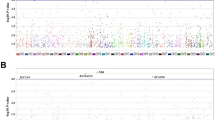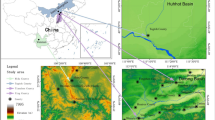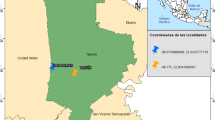Abstract
Heavy metals, including arsenic and lead, may lead to cellular oxidative damage that is linked to hypertension. Manganese superoxide dismutase (MnSOD) is a scavenger of reactive oxygen species, and 8-oxoguanine DNA glycosylase (OGG1) is the major glycosylase that repairs DNA lesions. Interestingly, whether there is an elevated risk of hypertension with arsenic or lead exposure in individuals with genetic variations in MnSOD or OGG1 has not yet been investigated. Questionnaires were administered to 240 Taiwanese rural residents. Blood pressure and biochemical indicators were assessed in each subject. Urinary levels of arsenic and lead were measured with atomic absorption spectrometry; and MnSOD and OGG1 genotypes were identified via polymerase chain reaction. There was a dose–response relationship between urinary arsenic levels and risk of hypertension (P = 0.021, test for trend). However, there was no association between urinary lead levels and hypertension risk. Individuals with high urinary arsenic levels and the MnSOD Val–Ala/Ala–Ala genotypes had a greater risk of hypertension than those with low urinary arsenic levels and the MnSOD Val–Val genotype (odds ratio [OR] = 4.2, 95% confidence interval [CI] = 1.7–10.3). Subjects with a high urinary arsenic level and the OGG1 Cys–Cys genotype also had a greater risk of hypertension than those with a low urinary arsenic level and the OGG1 Ser–Ser/Ser–Cys genotypes (OR = 3.4, 95% CI = 1.1–10.7). Thus, both MnSOD and OGG1 genotypes may be prone to an increased risk of hypertension associated with arsenic exposure.
Similar content being viewed by others
References
Ambrosone CB, Freudenheim JL, Thompson PA, Bowman E, Vena JE, Marshall JR, Graham S, Laughlin R, Nemoto T, Shields PG (1999) Manganese superoxide dismutase (MnSOD) genetic polymorphisms, dietary antioxidants, and risk of breast cancer. Cancer Res 59:602–606
Becker MA, Schumacher HR Jr, Wortmann RL, MacDonald PA, Eustace D, Palo WA, Streit J, Joseph-Ridge N (2005) Febuxostat compared with allopurinol in patients with hyperuricemia and gout. N Engl J Med 353:2450–2461
Beyer WF Jr, Fridovich I (1991) In vivo competition between iron and manganese for occupancy of the active site region of the manganese-superoxide dismutase of Escherichia coli. J Biol Chem 266:303–308
Bhatnagar A (2004) Cardiovascular pathophysiology of environmental pollutants. Am J Physiol Heart Circ Physiol 286:H479–H485
Bohr VA, Stevnsner T, de Souza-Pinto NC (2002) Mitochondrial DNA repair of oxidative damage in mammalian cells. Gene 286:127–134
Buchet JP, Lison D, Ruggeri M, Foa V, Elia G (1996) Assessment of exposure to inorganic arsenic, a human carcinogen, due to the consumption of seafood. Arch Toxicol 70:773–778
Cai H, Harrison DG (2000) Endothelial dysfunction in cardiovascular diseases: the role of oxidant stress. Circ Res 87:840–844
Chen CJ, Hsueh YM, Lai MS, Shyu MP, Chen SY, Wu MM, Kuo TL, Tai TY (1995) Increased prevalence of hypertension and long-term arsenic exposure. Hypertension 25:53–60
Cheng Y, Schwartz J, Sparrow D, Aro A, Weiss ST, Hu H (2001) Bone lead and blood lead levels in relation to baseline blood pressure and the prospective development of hypertension: the Normative Aging Study. Am J Epidemiol 153:164–171
Cheng TC, Chen ST, Huang CS, Fu YP, Yu JC, Cheng CW, Wu PE, Shen CY (2005) Breast cancer risk associated with genotype polymorphism of the catechol estrogen-metabolizing genes: a multigenic study on cancer susceptibility. Int J Cancer 113:345–353
Chu NF, Liou SH, Wu TN, Chang PY (1999) Reappraisal of the relation between blood lead concentration and blood pressure among the general population in Taiwan. Occup Environ Med 56:30–33
Cleland B, Tsuchiya A, Kalman DA, Dills R, Burbacher TM, White JW, Faustman EM, Mariën K (2009) Arsenic exposure within the Korean community (United States) based on dietary behavior and arsenic levels in hair, urine, air, and water. Environ Health Perspect 117:632–638
de Souza-Pinto NC, Hogue BA, Bohr VA (2001) DNA repair and aging in mouse liver: 8-oxodG glycosylase activity increase in mitochondrial but not in nuclear extracts. Free Radic Biol Med 30:916–923
EL-Safty IA, Afifi AM, Shouman AE, EL-Sady AK (2004) Effects of smoking and lead exposure on proximal tubular integrity among Egyptian industrial workers. Arch Med Res 35:59–65
Fujimoto H, Taguchi J, Imai Y, Ayabe S, Hashimoto H, Kobayashi H, Ogasawara K, Aizawa T, Yamakado M, Nagai R, Ohno M (2008) Manganese superoxide dismutase polymorphism affects the oxidized low-density lipoprotein-induced apoptosis of macrophages and coronary artery disease. Eur Heart J 29:1267–1274
Gamble MV, Liu X, Ahsan H, Pilsner R, Ilievski V, Slavkovich V, Parvez F, Levy D, Factor-Litvak P, Graziano JH (2005) Folate, homocysteine, and arsenic metabolism in arsenic-exposed individuals in Bangladesh. Environ Health Perspect 113:1683–1688
Gerhardt RE, Hudson JB, Rao RN, Sobel RE (1978) Chronic renal insufficiency from cortical necrosis induced by arsenic poisoning. Arch Intern Med 138:1267–1269
Goodarzi F, Huggins FE (2001) Monitoring the species of arsenic, chromium and nickel in milled coal, bottom ash and fly ash from a pulverized coal-fired power plant in western Canada. J Environ Monit 3:1–6
Huang PL, Wang MF, Lee HS, Liu YJ, Chen CC, Chen SC, Lai JS, Wong RH (2011) An OGG1 polymorphism is associated with mitochondrial DNA content in pesticide-exposed fruit growers. Toxicology 287:8–14
Janssen K, Schlink K, Götte W, Hippler B, Kaina B, Oesch F (2001) DNA repair activity of 8-oxoguanine DNA glycosylase 1 (OGG1) in human lymphocytes is not dependent on genetic polymorphism Ser326/Cys326. Mutat Res 486:207–216
Kang D, Nishida J, Iyama A, Nakabeppu Y, Furuichi M, Fujiwara T, Sekiguchi M, Takeshige K (1995) Intracellular localization of 8-oxo-dGTPase in human cells, with special reference to the role of the enzyme in mitochondria. J Biol Chem 270:14659–14665
Kile ML, Hoffman E, Hsueh YM, Afroz S, Quamruzzaman Q, Rahman M, Mahiuddin G, Ryan L, Christiani DC (2009) Variability in biomarkers of arsenic exposure and metabolism in adults over time. Environ Health Perspect 117:455–460
Kim R, Rotnitsky A, Sparrow D, Weiss S, Wager C, Hu H (1996) A longitudinal study of low-level lead exposure and impairment of renal function. The Normative Aging Study. JAMA 275:1177–1181
Kim JI, Park YJ, Kim KH, Kim JI, Song BJ, Lee MS, Kim CN, Chang SH (2003) hOGG1 Ser326Cys polymorphism modifies the significance of the environmental risk factor for colon cancer. World J Gastroenterol 9:956–960
Kohno T, Shinmura K, Tosaka M, Tani M, Kim SR, Sugimura H, Nohmi T, Kasai H, Yokota J (1998) Genetic polymorphisms and alternative splicing of the hOGG1 gene, that is involved in the repair of 8-hydroxyguanine in damaged DNA. Oncogene 16:3219–3225
Li PF, Dietz R, von Harsdorf R (1997) Differential effect of hydrogen peroxide and superoxide anion on apoptosis and proliferation of vascular smooth muscle cells. Circulation 96:3602–3609
Lopez S, Miyashita Y, Simons SS Jr (1990) Structurally based, selective interaction of arsenite with steroid receptors. J Biol Chem 265:16039–16042
McElroy JA, Shafer MM, Gangnon RE, Crouch LA, Newcomb PA (2008) Urinary lead exposure and breast cancer risk in a population-based case-control study. Cancer Epidemiol Biomarkers Prev 17:2311–2317
Micciolo R, Canal L, Maranelli G, Apostoli P (1994) Non-occupational lead exposure and hypertension in northern Italy. Int J Epidemiol 23:312–320
Mierzwa J, Adeloju SB, Dhindsa HS (1997) Slurry sampling for hydride generation atomic absorption spectrometric determination of arsenic in cigarette tobaccos. Analyst 122:539–542
Møller L, Kristensen TS (1992) Blood lead as a cardiovascular risk factor. Am J Epidemiol 136:1091–1100
Nelson KW (1977) Industrial contributions of arsenic to the environment. Environ Health Perspect 19:31–34
Novák M, Emmanuel S, Vile MA, Erel Y, Véron A, Paces T, Wieder RK, Vanecek M, Stepánová M, Brízová E, Hovorka J (2003) Origin of lead in eight Central European peat bogs determined from isotope ratios, strengths, and operation times of regional pollution sources. Environ Sci Technol 37:437–445
Panza JA, Quyyumi AA, Brush JE Jr, Epstein SE (1990) Abnormal endothelium-dependent vascular relaxation in patients with essential hypertension. N Engl J Med 323:22–27
Rahman M, Tondel M, Ahmad SA, Chowdhury IA, Faruquee MH, Axelson O (1999) Hypertension and arsenic exposure in Bangladesh. Hypertension 33(1):74–78
Rose GA, Blackburn H, Gillum RF, Prineas RJ (1982) Cardiovascular survey methods, 2nd edn. World Health Organization, Geneva
Rosenblum JS, Gilula NB, Lerner RA (1996) On signal sequence polymorphisms and diseases of distribution. Proc Natl Acad Sci USA 93:4471–4473
Ross R (1986) The pathogenesis of atherosclerosis—an update. N Engl J Med 314:488–500
Shimoda-Matsubayashi S, Matsumine H, Kobayashi T, Nakagawa-Hattori Y, Shimizu Y, Mizuno Y (1996) Structural dimorphism in the mitochondrial targeting sequence in the human manganese superoxide dismutase gene. A predictive evidence for conformational change to influence mitochondrial transport and a study of allelic association in Parkinson’s disease. Biochem Biophys Res Commun 226:561–565
Slama M, Susic D, Frohlich ED (2002) Prevention of hypertension. Curr Opin Cardiol 17:531–536
Stohs SJ, Bagchi D (1995) Oxidative mechanisms in the toxicity of metal ions. Free Radic Biol Med 18:321–336
Tarng DC, Tsai TJ, Chen WT, Liu TY, Wei YH (2001) Effect of human OGG1 1245C– > G gene polymorphism on 8-hydroxy-2′-deoxyguanosine levels of leukocyte DNA among patients undergoing chronic hemodialysis. J Am Soc Nephrol 12:2338–2347
Waeber B, Brunner HR, Joint National Committee in the US (JNC-VI); World Health Organization-International Society of Hypertension (WHO-ISH) (2001) The multifactorial nature of hypertension: the greatest challenge for its treatment? J Hypertens Suppl 19:S9–16
Wong RH, Hu CW, Yeh CY, Chao MR, Chen CC, Huang JH, Chang SH, Lee SI, Lee HS (2008) Sulfotransferase 1A1 and glutathione S-transferase P1 genetic polymorphisms modulate the levels of urinary 8-hydroxy-2′-deoxyguanosine in betel quid chewers. Arch Toxicol 82:313–321
Woo SH, Park IC, Park MJ, Lee HC, Lee SJ, Chun YJ, Lee SH, Hong SI, Rhee CH (2002) Arsenic trioxide induces apoptosis through a reactive oxygen species-dependent pathway and loss of mitochondrial membrane potential in HeLa cells. Int J Oncol 21:57–63
World Health Organization (1981) Environmental health criteria 18: arsenic. World Health Organization, Geneva
Zafari AM, Ushio-Fukai M, Akers M, Yin Q, Shah A, Harrison DG, Taylor WR, Griendling KK (1998) Role of NADH/NADPH oxidase-derived H2O2 in angiotensin II-induced vascular hypertrophy. Hypertension 32:488–495
Acknowledgments
This study was supported by a grant from Chung Shan Medical University Hospital (CSH-2010-C-11).
Author information
Authors and Affiliations
Corresponding author
Rights and permissions
About this article
Cite this article
Chen, SC., Chen, CC., Kuo, CY. et al. Elevated risk of hypertension induced by arsenic exposure in Taiwanese rural residents: possible effects of manganese superoxide dismutase (MnSOD) and 8-oxoguanine DNA glycosylase (OGG1) genes. Arch Toxicol 86, 869–878 (2012). https://doi.org/10.1007/s00204-011-0797-8
Received:
Accepted:
Published:
Issue Date:
DOI: https://doi.org/10.1007/s00204-011-0797-8




